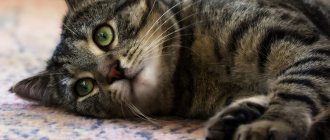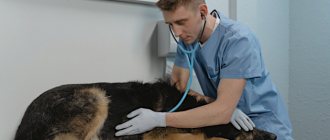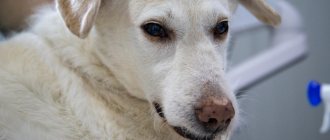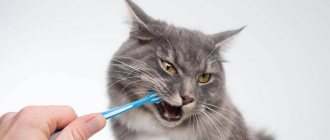Digestive disorders in domestic cats are relatively common. If your pet walks outside at least from time to time, problems with digestion become even more common. Unfortunately, not everything is always limited to just digestive disorders. When a cat has bloody diarrhea, it must be taken to the veterinarian. There is a good chance that this “trouble” indicates some dangerous disease. Perhaps it poses a danger not only to the health, but even to the life of your beloved pet.
general information
Diarrhea is the rapid “evacuation” of semi-digested contents of the small intestine, accompanied by cramps, intoxication and dehydration. The total amount of feces excreted by the cat increases several times. By the way, if your pet has diarrhea, in what cases is it advisable to call a veterinarian? Frankly speaking, he needs to be called whenever the cat has some kind of “problem” with digestion. The specialist needs to know when and after what they started, and how the cat feels at this time.
It is necessary to urgently consult a doctor in cases where, in addition to feces, the stool contains mucous inclusions, a lot of undigested pieces of food, etc.
Never give your cat “human” medications unless advised by your veterinarian! So you can “easily and naturally” poison your pet!
If your cat has yellow diarrhea
The color of excrement is affected by bilirubin, which is part of bile. It is secreted by the liver and from there it enters the intestines. In the colon it is oxidized to stercobilin, which gives dark color to stool.
Disturbances in the oxidative process may be associated with dysbiosis caused by poor nutrition. Overfeeding an animal or heavy food puts stress on the liver, impairing its function. The gland secretes excess amounts of bilirubin.
The body eliminates excess in undigested form. Liver dysfunction can be caused by pathologies: hepatitis, pancreatitis.
Predisposing factors
Very often, diarrhea is a direct consequence of one of dozens of possible intestinal (or stomach) diseases. Secondary diarrhea (which arose as a response to the pathology of another organ) is much less common. And this is good, since it is easier to cure a diseased intestine than, for example, kidneys or liver. Thus, in most cases, gastrointestinal disease should be suspected.
Again, the digestive system of cats is quite “strong”. In most cases, diarrhea (even with blood) is sporadic, often everything goes away spontaneously, even without providing the animal with any medical assistance. In addition, often the root cause of what is happening remains “in the shadows,” since some intestinal pathologies can only be identified in a very well-equipped veterinary clinic. Let's look at the most common causes of diarrhea:
- Diet. If a cat is suddenly switched to a different type of food (for example, from dry to canned), diarrhea is almost guaranteed. Fortunately, cases of such diarrhea often resolve spontaneously, and the pathology does not lead to anything serious. If the owners “spare” the cat by gradually introducing new food, its intestines can even adapt to the new diet without external “special effects.” Much more dangerous are cases when a cat develops diarrhea with blood due to feeding the animal food that it should not have been given at all. Thus, diarrhea with blood is quite possible in cats that are fed stale food from the refrigerator. In addition, some pets may be intolerant to seemingly “classic” foods. In particular, bloody and liquid feces can be... after milk. Many cats generally cannot digest it!
- Infectious factors. There are a huge number of infectious disease pathogens that can cause intestinal problems. Feline parvovirus and the causative agent of feline leukemia are especially dangerous. In addition, bloody diarrhea in a kitten is often caused by salmonella and campylobacter, as well as microscopic parasites (such as intestinal giardia, parabasalia and coccidia). It is necessary to take into account that all these pathogens are not “satisfied” with one pet: if you have more than one cat, you will have to treat all of them.
- Food allergies. We have already indirectly mentioned a similar problem, but this is still something else. In the case of food intolerance, diarrhea develops with a sudden change in diet, and in this case the animal gradually develops intolerance to some component of the food. And this, by the way, greatly complicates the diagnosis, since long-term food is the last to be suspected.
- Inflammatory bowel disease. Also a huge group of factors. They are often responsible for cases of sudden, spontaneous “bloody” diarrhea. This happens sporadically; if the cat has access to the street, the owners may not notice anything for weeks. Again, the problem is that inflammatory phenomena can be a consequence of poor nutrition, allergies, etc.
- Intestinal tumors. A real scourge of old cats. Most often, they are found to have various types of lymphomas and adenocarcinomas. A relatively “characteristic” symptom is alternating diarrhea and constipation. Unfortunately, intestinal tumors in cats are usually diagnosed at the most advanced stages.
- Benign polyps. Of course, benign neoplasms do not pose a direct threat to the life and health of a pet, but they may well be the cause of inflammatory processes, diarrhea and obstruction.
Other nuances
A common cause of regular diarrhea in cats may be pancreatic insufficiency . But, unlike dogs, cats suffer from this pathology very rarely. How are problems with the pancreas related to diarrhea? Everything is quite simple - this organ secretes a huge amount of enzymes that are vital for digestion. If they are not there, the food stagnates, the digestion process stops, and putrefactive processes occur in the feces. All this leads to damage to the intestinal mucosa (that’s where the blood comes from) and to diarrhea.
Don't forget about helminthic diseases . If your pet has access to the outdoors and rarely sees the vet, there are probably “guests” in his intestines. Some varieties of parasites are downright exemplary “guests”; their presence in the gastrointestinal tract has almost no effect on the general condition of the animal. Others are quite aggressive. Their presence can be easily recognized by signs of exhaustion, food perversions in the pet, as well as cases of bloody diarrhea, alternating with periods of severe constipation. In addition, helminth infestations are especially difficult in pregnant cats: a pregnant cat’s body already has a hard time, and helminth toxins only make the situation worse.
A rather “interesting” cause of bloody diarrhea may be a lack of vitamin B12 . Until now, the mechanism of this process has not been fully studied, but there is still a relationship between vitamin deficiency and diarrhea. Vitamin deficiency is diagnosed by a biochemical blood test. As a rule, the condition of the animal’s intestines returns to normal after the administration of multivitamin preparations.
Another cause may be systemic diseases . This refers to serious illnesses in which diarrhea is only an indirect symptom, mistakenly mistaken by many owners for the main pathology. Systemic diseases that often lead to this result include: hyperthyroidism (increased secretion of the thyroid gland), liver and kidney disease. By the way, vomiting bile additionally indicates problems with the liver.
Causes and associated symptoms
The causes of bloody diarrhea in cats are:
- bacterial diseases (for example, salmonellosis);
- viral infections (feline leukemia, “feline distemper”);
- tumors;
- parasites (roundworms, tapeworms);
- foreign bodies;
- change in diet;
- food allergies;
- eating grass;
- food poisoning;
- increased levels of thyroid hormones;
- use of medications;
- toxoplasmosis;
- gastroenteritis.
Bloody diarrhea may be accompanied by vomiting, fever, and lack of appetite. The animal becomes lethargic. The nose is dry and warm to the touch.
Clinical picture
Of course, the main and undeniable symptom is diarrhea. The main difficulty lies in determining the location of the lesion. There is a big difference in the treatment of the small and large intestines. In particular, if a pet has problems with the large intestine, the owner will be able to observe the following for their pet:
- Increased frequency of attempts to defecate.
- The animal will strain very hard.
- There will be clearly visible blood in the stool, as well as mucus.
On the contrary, with lesions of the small intestine (except for cases of very severe hemorrhages), you most likely will not see blood in the stool at all. More precisely, the stool will be a blackish-brown mass called melena. This is what digested blood looks like. Accordingly, in episodic and rare situations where it enters the small intestine, the owners may not notice anything at all. The feces will just be a little darker than normal. If a cat goes outside to do “business”, he may well die “safely” from intestinal bleeding and anemia.
So the conclusion is simple. It is not always possible to learn about diarrhea (except in advanced situations) “visually”. However, when an exhausted and exhausted cat begins to walk under itself, everything becomes obvious, but it may be too late to treat it. You need to look at the general condition of your pet and examine it more often. A healthy cat will never have fecal marks on the fur around the anus . If any are observed, we are 100% talking about diarrhea.
If your cat has diarrhea with blood and/or mucus
Bloody or mucous discharge is a severe symptom. Mucus is a substance secreted by cells containing antibodies.
The cell reaction is protective and indicates the entry of pathogenic substances into the body. Mucous stool without blood is often observed after deworming. Anthelmintic drugs contain substances that not only kill parasites, but also activate the body's protective functions.
Be sure to read:
A cat is vomiting hair: reasons, what to do, medications and folk remedies, prevention
Blood appears when the walls of the small or large intestine are damaged.
Causes:
- changes in diet, food intolerance;
- intestinal parasites (giardia);
- toxoplasmosis is a disease caused by single-celled parasites Toxoplasma gondii;
- injury or abscess of the digestive organs;
- idiopathic megacolon;
- intoxication;
- oncology.
If blood or mucus is detected, seek medical attention.
Maintenance therapy
In mild cases, only supportive therapy can be used. First, you need to give your digestive tract a rest. Fasting for 24 hours has been shown without medication. Please note that, due to the nature of the digestive system of cats, depriving them of food for more than a day is strongly not recommended! There can be extremely negative consequences for the pet's health.
The second point is prescribing a light diet, which also allows you to relieve the pet’s gastrointestinal tract. In relatively mild cases, you can feed your pet boiled rice and chicken for about a week, but in case of long-term treatment, a special diet is required, which only a doctor can prepare. In addition, if there is even a slight suspicion of food intolerance, it is imperative to exclude all possible allergens. In these cases, special diets prescribed only by veterinarians are often used. And further. If your cat regularly experiences problems from dry food, it is better to stop feeding it to the animal immediately.
Probiotics are an excellent way to treat many digestive disorders. This is the name given to cultures of beneficial microorganisms, the intake of which normalizes the digestion process. By the way, they are prescribed (should, in any case) after a course of antibiotics. Note that today special preparations are produced specifically for cats (and dogs).
In addition, treatment at home should include giving a sufficient volume of fluid . A sick animal should have unlimited access to clean drinking water at any time of the day. In addition, in special cases, it may be necessary to water your pet with special electrolyte solutions, the choice of which is also advisable to consult with a veterinarian.
Specific therapy
In general, the treatment of bloody diarrhea largely depends on many factors and underlying causes, and therefore it is difficult to talk about anything specific. But still, the general provisions need to be described:
- Antibacterial and antiparasitic drugs . But only in cases where the pathogens are known from the results of diagnostic studies! Under no circumstances should such medications be prescribed and used “for prevention” or at random, as this is fraught with serious consequences.
- Anti-inflammatory drugs and immunosuppressants . They are often used in the treatment of inflammatory bowel disease.
- For tumors (including benign ones), surgery is recommended.
- When vitamin B12 deficiency , its injection is prescribed. Moreover, in advanced cases, only injections will help - the intestines of a sick cat may be in such a state that they simply cannot absorb nutrients, trace elements and vitamins.
Medicines and dosage for diarrhea in cats
Drug therapy is prescribed by a veterinarian.
| name of the drug | pharmachologic effect | dosage |
| Lignitin (tablets) | absorbent, antidiarrheal | table/2 kg weight, 7-10 days |
| Loperamide (tablets) | antidiarrheal | 0.5 mg/0.4 kg body weight, every 8 hours |
| Enterofuril (suspension) | broad spectrum antimicrobial | 1 ml/2.5 kg, no more than 5 days |
| Furazolidone | synthetic antibiotic | the diagram is signed by a veterinarian |
| Phthalazole | Anti-inflammatory, antibacterial | the dosage is determined by the doctor |
| EnteroZoo (paste) | detoxification | 2 tsp / 2 kg |
To restore the microflora, they follow a diet and give bifidobacteria and lactobacilli.
Chronic diarrhea: what is it?
When describing diarrhea, breeders can only identify visible symptoms, such as foul-smelling and frequent bowel movements, poor health of the cat or dog, and external changes. But in fact, chronic diarrhea is a complex syndrome, observed over 2-3 weeks, which includes a lot of invisible aspects, sometimes difficult to diagnose.
At the first stage of the examination, it is important to understand whether acute or chronic diarrhea is present. This is important, since in acute conditions it is enough to conduct a series of standard laboratory tests, relieve the syndrome and prescribe supportive symptomatic therapy.
In chronic cases, everything is not so simple! The main thing is to find the “focus” due to which regular diarrhea occurs and prescribe etiotropic therapy.
At the second stage, you need to figure out whether the diarrhea is small intestinal or colonic, or of mixed origin.
Clinical observations in chronic diarrhea:
- no weight loss (colic diarrhea). As an exception, weight is lost, but then streaks of blood and mucus are present in the stool (severe course);
- changes in body condition or severe weight loss (small intestinal diarrhea).
Important! The impact of protozoa on the intestines should not be ruled out. In particular, Giardia, which “loves” the small intestine. And trichomonas, which cause symptoms of chronic diarrhea in cats, settle in the large intestine and do not respond to standard drugs against Giardia (Fenbendazole, Metronidazole, Albendazole).
What to feed?
Increasing your fiber intake is a good option, as it is considered an excellent corrective (good for constipation, but also good for diarrhea). However, veterinarians believe that it is best to feed your cat in smaller meals, consisting of several small meals (say, 4 per day), consisting of something easily digestible. This means a low-calorie, mostly carbohydrate diet such as potatoes, pasta or rice (with a little chicken), turkey, low-fat cottage cheese or yogurt. Some cats will also happily eat meat-based baby food.
Entry of foreign bodies into the body
Small inedible objects that a cat swallows while playing or eating often cause indigestion for the animal. Such objects can be different in shape, size and structure.
When a foreign body enters the pet’s intestines, malaise manifests itself through refusal to eat, repeated vomiting, bowel problems in the form of constipation or diarrhea, lethargy, irritability when touched or stroking the abdomen. If a foreign object does not leave the body naturally and remains there for more than a day, inflammation develops, as a result of which intestinal motility is disrupted, tissue necrosis and perforation of the mucous membranes, and septic processes begin. In this case, only surgical intervention can help a sick animal. It should be borne in mind that the manifestation of all the above symptoms is not always complex. This means that even only one of them can arise. With partial intestinal blockage, the cat can maintain normal physical activity, a healthy appetite and bowel movements. If at least one of the alarming symptoms still makes itself felt, you should show the animal to a veterinarian.











